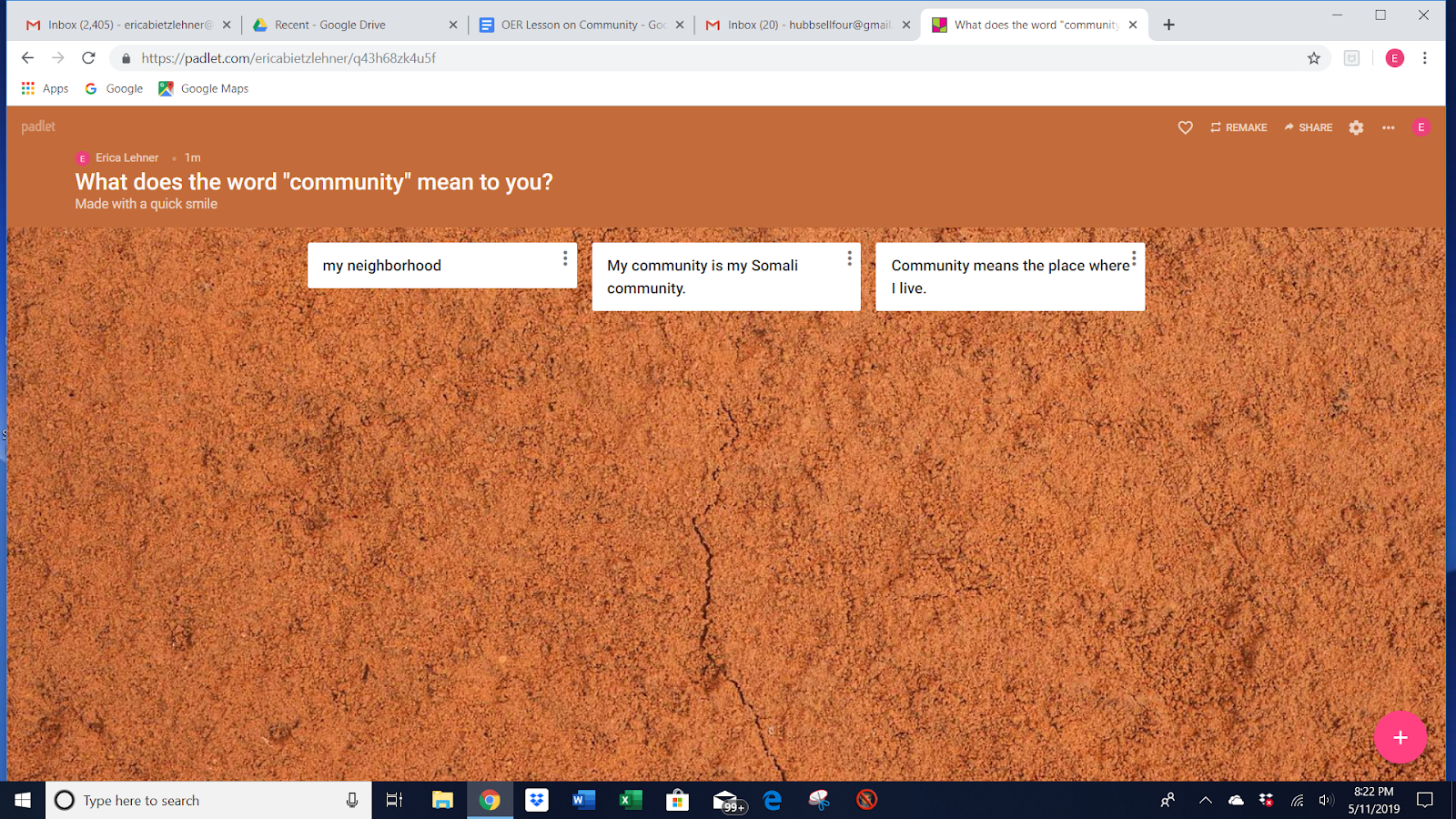Your Community
Title: Your Community
Overview: This is the first introductory lesson for a 5-6 week thematic unit on community. It is designed to look at what the meaning of community is and to point out that we belong to different types of communities (eg. a community where you live, study, worship, work, etc.) The culminating project of this unit is a class project where each student writes and publishes a paragraph and photo about a favorite place in their community.
Content/Context: This course is designed for a group of approximately 25 adult learners with roughly an intermediate level of English (CASAS scores 211-221).
Length of lesson: Approximately 2.5 hours
Digital Literacy Standards addressed:
Review:Internet basics: 1. Identify the different ways a person can connect to the internet 10. Identify address bar and demonstrate understanding of its functionality (specifically as used on the phone).
New: Internet basics: 9. Fill out an online form (students need to find the correct box to fill in, type their reply and find the “done” button in order to post). Informational Literacy 15. Synthesize relevant information from one or more sources. Informational LIteracy 16. Integrate new information into current knowledge and use it to support understanding, views, perspectives or opinions.
College and Career Readiness Standards (CCRS) and/or Transitions Integration Framework (TIF) Standards addressed: CCRS Writing Anchor 6 levels A &B:Use technology, including the internet, to produce and publish writing and to interact and collaborate with others. CCRS Speaking Anchor 1: Prepare for and participate effectively in a range of conversations and collaborations with diverse partners, building on others’ ideas and expressing their own clearly and persuasively.
Lesson Objective(s): At the end of this lesson, students will be able to: 1. articulate different communities they belong to, 2. identify ways they participate in these communities, 3. access a digital tool to share their ideas about community
Assessing Mastery of the Objective(s): At the end of this lesson, students will show mastery of the objectives as evidenced by 1. Participating in a community building activity that involves moving around the room based on whether they strongly agree, agree, disagree, or strongly disagree to statements about their community. 2. Responding to an exit question on padlet.
Materials/links: www.padlet.com
Create a padlet at the above website. On Padlet’s page, click on the more dots and click modify. Scroll down to the bottom and there is a place to create the padlet address to your specific page. This link can then be given to students so they can access the class padlet from their phone. Your page may look similar to the one below.
Lesson Outline:
Introduction: A slip of paper with a padlet link will be on each desk. Padlet will be projected up front. Students, with the help of the teacher will use their phones to respond to the Padlet question, “What does the word ‘community’ mean to you?” Several teacher examples will be displayed already on the padlet. Teacher will circulate to ensure students are connected to wifi and can get to the link. If your teaching site has wifi, students may need to be reminded to sign in to it.
Explanation/Modeling: Together, look at the responses and begin to flesh out the meaning of the word community and the different ways that it’s used. From here we will move to small group discussions about community. Teacher will circulate during the discussion. Small group questions can include but are not limited to:
- What do you like about your community?
- How did you decide to live in your community?
- What do you think should be changed in your community?
- How can you help your community?
- How many of your neighbors do you know?
- Are there old people living in your community? Tell your group about them.
- Does your community have special days to get together?
Guided Practice: Students will read an article from Marshall ABE 6.0 called Being a Good Citizen. http://resources.marshalladulteducation.org/rs/hc/l6hc/Being_a_Good_Citizen_Level_6.0.pdf After reading the article, in pairs students will discuss the 7 questions included with the article. When most students have finished, the class will look at the 7 questions and their answers as a large group.
Independent Practice: Time to stand up and move around. In four spots around the room will be the words, STRONGLY AGREE, AGREE, DISAGREE, STRONGLY DISAGREE. Teacher may need to define these words. As the teacher reads a list of 15 statements about community, students will move to the sign that fits their response to that statement. Some examples of statements include:
- My city is a place that is welcoming to me.
- My city has safe places for me to live in.
- I am a part of a learning community.
- The police in my community are fair.
- I can find a job in my community.
- I know ways to volunteer in my community.
- There are good parks for kids in this community.
- It’s easy to get around in my community.
- It’s not hard to get around without a car in my community.
- I know how to find out about events in my community.
- I know the rules and laws in my community.
- I know some neighbors in my community.
- People in my community are friendly.
- I have attended an event in my community.
- I have helped someone in my community.
Student Reflection on Learning, Closure, Connection: Students will respond to a final padlet question. 1. What are some ways you can be more involved in your community?
